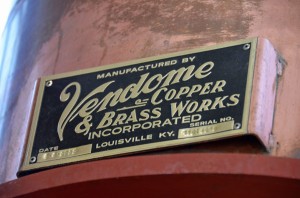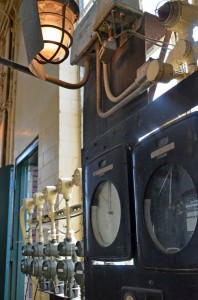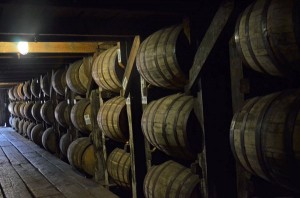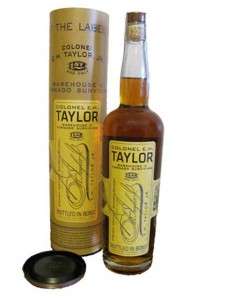Close-Up on Buffalo Trace, Part I
Part 1 of an Interview with Buffalo Trace’s Chris Fletcher, Lead Chemist, and Amy Preske, Public Relations Manager
By Richard Thomas

(Credit: Joana Thomas)
During a recent visit to the Buffalo Trace distillery in Frankfort, Kentucky, I had the opportunity to have lunch with the distillery’s Lead Chemist, Chris Fletcher, and their Public Relations Manager, Amy Preske, during which I interviewed them at length about the inner workings of Buffalo Trace, as well as the ins and outs of working in the whiskey trade. The conversation went on for so long, in fact, that I have had to break the interview into two parts.
This installment covers the features of the Buffalo Trace distillery and certain aspects of its operations. On Monday, The Whiskey Reviewer will publish Part II of the interview, dealing with the more personal aspects of working for Buffalo Trace and in the whiskey industry.
RT: When it comes to distilleries, whiskey fans are always interested in the equipment, the still. Buffalo Trace is a two-century old distillery, but I saw copper on the main still dated as recently as 2010. What is the oldest working piece of equipment here?

(Credit: Joana Thomas)
CF: Do you count warehouses? Warehouse C is from 1881. On the distillery side, it seems to me most of the equipment is from after Prohibition. 1940s, 40ish. But I would say as far as the oldest working, functioning thing, that would be the warehouses.
AP: When you were on the tour, you must have walked past the workshop. We have to make a lot of our own parts here, because everything is so old. A lot of things are really just cobbled together. Things break and we patch them and fix them.
RT: I was asking Fred (the tour guide) about your water supply, and he said part of it came from Frankfort’s municipal supply, and part of it comes from a local spring. What would you use the municipal water for, and what do you use the spring water for?
AP: We use [Kentucky River] water too.
RT: Yes, but that is strictly for cooling, as I understand it.
CF: Right, the water we use [for cooling] is completely untreated river water. Now the water we use for the product is going through a reverse osmosis purification system. Anything we use, whether it has been pre-treated by the city or comes from another water source, it all goes through that purification process so that, number one, it’s consistent, we don’t have to worry about bringing in an ingredient that’s going to affect our product. That’s very common in this business.
RT: One of the curios you have here is Warehouse V, the world’s smallest bonded warehouse. What do you do with a one-barrel storage facility?
AP: It was originally done for our two millionth barrel, as part of a big celebration for our two millionth barrel, so that is why it was originally built. Currently it is holding our six millionth barrel, and it’s held every millionth barrel since [the two million mark]. The only time it has not held a millionth barrel is when we took out the five millionth barrel and replaced it with a millennium barrel.
We recently released that millennium bottling to charity, and it yielded about 174 bottles, all of it to charity, and the charities can do whatever they like with it. They raffled it off, and raised about $150,000, and the only thing we asked was that they report back to us and tell us how much they raised. So once we got that out there we replaced it with our six millionth barrel, and that was in May of 2008.

(Credit: Joana Thomas)
RT: So Warehouse V is fundamentally symbolic?
AP: Yeah, it’s not a great aging warehouse. [Laughing] We hope no one has drunk the millennium barrel bottles. It might not taste the greatest. We did finish the aging in another warehouse, so hopefully that got some more natural feel to it.
RT: One special thing about Buffalo Trace is that you have a broad, deep line of whiskeys, with several individual and quite distinctive brands. How do you get inspiration for and craft a new product?
CF: This might sound a little bit unbelievable, so I should tell you some background before I answer. I came from another distillery, almost two years ago now. Fine product, but all the same and consistent basically. And one of the really refreshing things here, as a whiskey chemist, was being able to sit in on the first few meetings as far as operations, kind of behind the scenes.
We literally sit down, Harlen [Wheatley, the Master Distiller]; myself; my boss; a few other people; Mark [Brown], our president. And no suggestion is too big or too small. I really felt like, in my first meeting when I started here, that if I had a suggestion for Mark or for Harlen, it would be taken just as seriously as anyone else. Let’s see what we can do, maybe this will work, maybe it won’t.

That’s what you see in the experimental collections and the other brands that we’re bringing out now, like the [Colonel E.H.] Taylor bourbons. I guess we did have some good luck or bad luck with the tornado barrels, and it just happened to work out that way.
But as a scientist, as a whiskey scientist, being able to get your hands dirty with different ideas and what could this experiment potentially lead to is really open for any employee. If they took it to Harlen or Mark, it would be taken seriously.
RT: So ideas come from all over the place. But if you had an idea, what would the process be like for dreaming that up and trying to implement it?
CF: You know, my background on the distillery side is more focused on from the grain to the distillation. That’s what my experience is in in the ten years in the industry. So the things you are going to be tinkering with around there are certainly regulated in some form or fashion. There are really only four or five things with bourbon you can do to make it different anyway, or else you’re not making bourbon.
So, for instance, you could play with your third grain, your flavoring grain. If you have the opportunity, you could use something else. You could use different types of malted barley. The beer industry has tons of different types of smoked malts and chocolate malts. There are all kinds of different things you could potentially do, and not giving anything away here, because we literally have a huge list, and who knows what will come next.
AP: I would think the fun part for you guys would be sourcing that stuff. So you say “we’re going to make something out of this.” OK, where do we find this? Or the wood, where does the wood for the barrels come from. We’ve got experiments going on with wood from all over the world.
RT: Like the French Oak experiment?
AP: Right.
***
To Continue, Click Here
to Jump to Part 2 of this Interview




Great stuff.